#light year
Explore tagged Tumblr posts
Text

Two views of the Cartwheel Galaxy (500 million light years from Earth)

373 notes
·
View notes
Text
DC OCs

Messenger of life: 🦉 Light Year: @averagecomic-l0ver
finally a digital drawing huh? lol
I don't remember how to draw
15 notes
·
View notes
Text

Feynman: When we were talking about the atoms, one of the troubles that people have with the atoms is that they're so tiny, and it's so hard to imagine the scale.
The size of the atoms are in size - compared to an apple, it's the same scale as an apple is to the size of the Earth. And that's a kind of a hard thing to take, and you have to go through all these things all the time, and people find these numbers inconceivable. And I do too.
The only thing you do is you just change your scale. I mean, you're just thinking of small balls, but you don't try to think of exactly how small they are too often! Or you'd get kind of a bit nutty, alright?
But in astronomy, you have the same thing in reverse because the distances to these stars is so enormous, you see. You know that light goes so fast that it only takes a few seconds to go to the moon and back, or it goes around the Earth seven-and-a-half times in a second. And goes for a year, two years, three years before it gets to the nearest other star that there is to us.
But all of our stars are... the stars that are nearby in a great galaxy, a big mass of stars, which is called a galaxy, a group, well this, our galaxy is... what is it? Something like a hundred thousand light years, a hundred thousand years.
And then there's another patch of stars. It takes a million years for the light to get here, going at this enormous rate.
And you just go crazy trying to make too "real" that distance, you have to do everything in proportion. It's easy - you say the galaxies are little patches of stars and they're ten times as far apart as they are big.
So that's an easy picture, you know - he gets it. But you just go to a different scale, that's easier. You know, once in a while you try to come back to... Earth scale to discuss the galaxies but it's kind of hard.
The number of stars that we see at night is about - only about 5,000. But the number of stars in our galaxy, the telescopes have shown when you improve the instrument... Oh! We look at a galaxy. We look at the stars. All the light that we see, the little tiny and influent spreads from the star over this enormous distance of what? Three light years, for the nearest star. On, on, on! This light from the stars spreading, the wavefronts are getting wider and wider, weaker and weaker, weaker and weaker out into all of space, and finally the tiny fraction of it comes in one square, eighth of an inch, tiny little black hole and does something to me, so I know it's there.
Well, to know a little bit more about it, I'd rather gather a little more of this little, this tiny fraction of this front of light, and so I make a big telescope, which is a kind of funnel that the light that comes over this big area - 200 inches across - is very carefully organised, so it's all concentrated back so it can go through a... pupil. Actually, it's better to photograph it, or nowadays they use photo cells, they're a better instrument.
But anyway, the idea of the telescope is to focus the light from a bigger area into a smaller area so that we can see things that are weaker, less light, and in that way we find there's a very large number of stars in the galaxy.
There's so many that if you tried to name them, one a second, naming all the stars in our galaxy, I don't mean all the stars in the universe, just this galaxy here, it takes 3,000 years.
And yet, that's not a very big number. Because if those stars were to drop one dollar bill on the Earth during a year, each star dropping one dollar bill, they might take care of the deficit which is suggested for the budget of the United States.
So you see what kind of numbers we have to deal with!
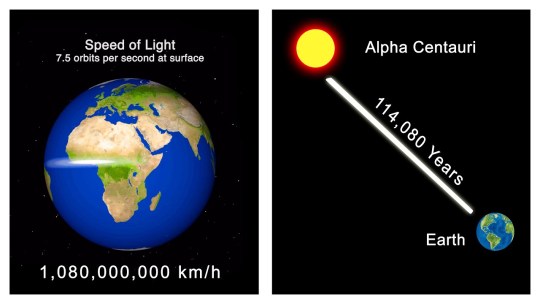
#Richard Feynman#space#astronomy#magnitude#scale#galaxy#milky way galaxy#light speed#speed of light#light year#science#religion is a mental illness
157 notes
·
View notes
Text
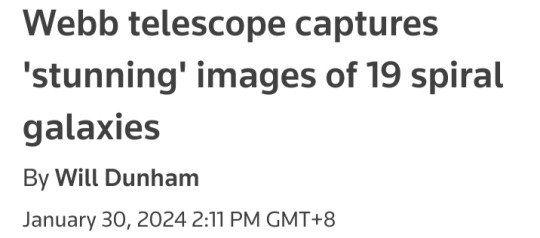
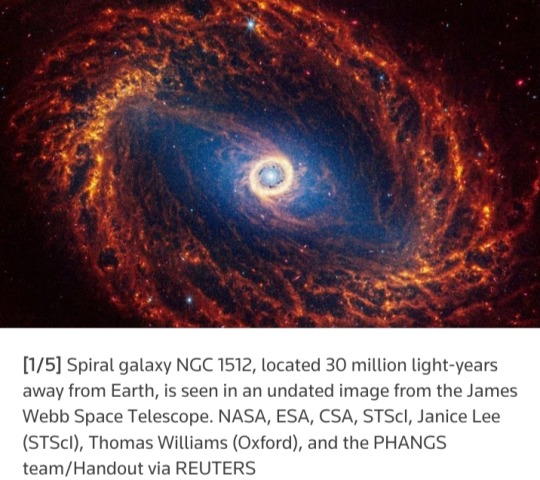
WASHINGTON, Jan 29 (Reuters) — A batch of newly released images captured by the James Webb Space Telescope show in remarkable detail 19 spiral galaxies residing relatively near our Milky Way, offering new clues on star formation as well as galactic structure and evolution.
The images were made public on Monday by a team of scientists involved in a project called Physics at High Angular resolution in Nearby GalaxieS (PHANGS) that operates across several major astronomical observatories.
The closest of the 19 galaxies is called NGC5068, about 15 million light years from Earth, and the most distant of them is NGC1365, about 60 million light years from Earth.
A light year is the distance light travels in a year, 5.9 trillion miles (9.5 trillion km).
The James Webb Space Telescope (JWST) was launched in 2021 and began collecting data in 2022, reshaping the understanding of the early universe while taking wondrous pictures of the cosmos.
The orbiting observatory looks at the universe mainly in the infrared.
The Hubble Space Telescope, launched in 1990 and still operational, has examined it primarily at optical and ultraviolet wavelengths.
Spiral galaxies, resembling enormous pinwheels, are a common galaxy type. Our Milky Way is one.
The new observations came from Webb's Near-Infrared Camera (NIRCam) and Mid-Infrared Instrument (MIRI).
They show roughly 100,000 star clusters and millions or perhaps billions of individual stars.
"These data are important as they give us a new view on the earliest phase of star formation," said University of Oxford astronomer Thomas Williams, who led the team's data processing on the images.
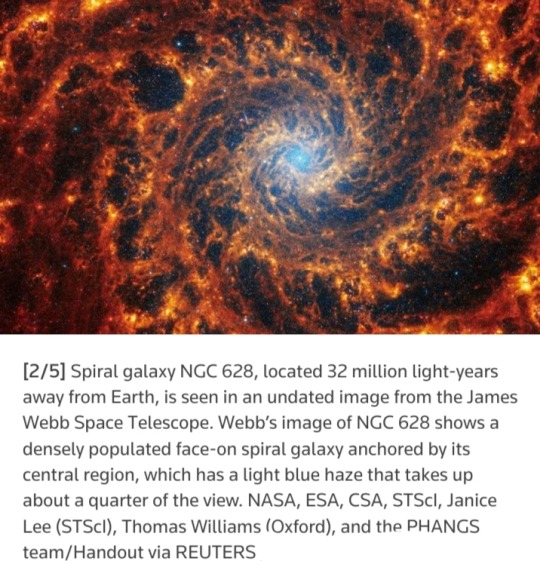
"Stars are born deep within dusty clouds that completely block out the light at visible wavelengths - what the Hubble Space Telescope is sensitive to - but these clouds light up at the JWST wavelengths.
We don't know a lot about this phase, not even really how long it lasts, and so these data will be vital for understanding how stars in galaxies start their lives," Williams added.
About half of spiral galaxies have a straight structure, called a bar, coming out from the galactic center to which the spiral arms are attached.
"The commonly held thought is that galaxies form from the inside-out, and so get bigger and bigger over their lifetimes.
The spiral arms act to sweep up the gas that will form into stars, and the bars act to funnel that same gas in towards the central black hole of the galaxy," Williams said.

The images let scientists for the first time resolve the structure of the clouds of dust and gas from which stars and planets form at a high level of detail in galaxies beyond the Large Magellanic Cloud and Small Magellanic Cloud, two galaxies considered galactic satellites of the sprawling Milky Way.
"The images are not only aesthetically stunning, they also tell a story about the cycle of star formation and feedback, which is the energy and momentum released by young stars into the space between stars," said astronomer Janice Lee of the Space Telescope Science Institute in Baltimore, principal investigator for the new data.
"It actually looks like there was explosive activity and clearing of the dust and gas on both cluster and kiloparsec (roughly 3,000 light years) scales.
The dynamic process of the overall star formation cycle becomes obvious and qualitatively accessible, even for the public, which makes the images compelling on many different levels," Lee added.
Webb's observations build on Hubble's.

"Using Hubble, we would see the starlight from galaxies, but some of the light was blocked by the dust of galaxies," University of Alberta astronomer Erik Rosolowsky said.
"This limitation made it hard to understand parts of how a galaxy operates as a system. With Webb's view in the infrared, we can see through this dust to see stars behind and within the enshrouding dust."
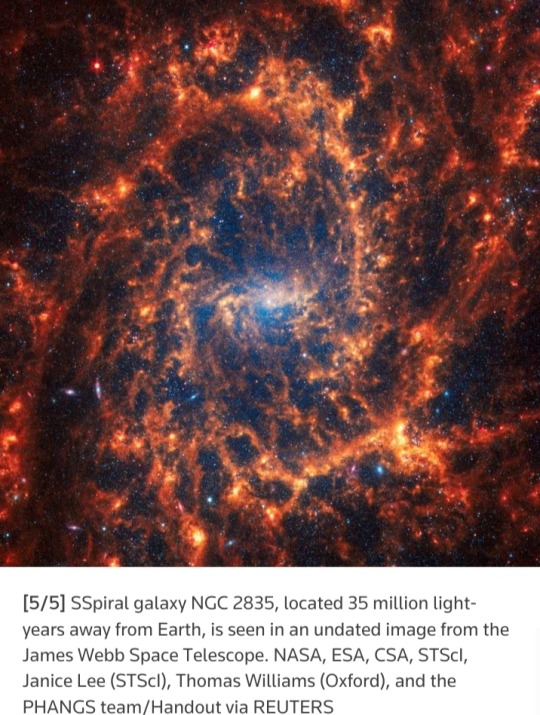
#James Webb Space Telescope#spiral galaxies#Milky Way#Physics at High Angular resolution in Nearby GalaxieS (PHANGS)#NGC5068#NGC1365#light year#Hubble Space Telescope#Near-Infrared Camera (NIRCam)#Mid-Infrared Instrument (MIRI)#astronomy#space#universe#cosmos#Large Magellanic Cloud#Small Magellanic Cloud#Space Telescope Science Institute
37 notes
·
View notes
Text
Light year – lasers like a light years

Pixel art for today based on videogame Star Wars Dark Forces for computer system Ibm Pc Ms Dos. It is a shooter with first person view. About Star Wars. About most real Star Wars. And it is so serious they have there! It is hard to be more serious! Space bases.
And blaster rifles! Such a big space station. In space. At the planets. When I launch the game, I was impressed by size. And so detailed rebuild of Star Wars universe. Everything is so real and three dimensional. And blasters pew pew. They fly in all the sides.
And this is my drawing based on Star Wars Dark Forces (Ms Dos). In space. You find out yourself at the space station. And it is a shooter about space. Light year. And laser is flying as a light year. Such a white flash before the eyes.
Fast space ship not big approach to space station. And slowly opened a entrance door. It is hiss from the door. Gear is rotating. Lamps are flashing. Electronics works. Door is slowly starting to open. A little of vapor. And door is opened. You go forward though the enter. It is a big space station. You have a blaster type stormtrooper rifle in your hands.
You are making enter with accuracy, and you go into a empty room. It is little dark here. And all around, a lamps are flashing here and there. And a noise from electronics machines make you calm, makes you feel calm. And lots of indicators are flashing. Every space station even a small space ship – it is a complex device. There are lots of computers and tech. And everything need to work good.
You are trying to make a silent steps. With the goal - no one to hear you. From the dark you are going into a light corridor. Here it is more light. You look at the different sides. No one is here. It is good. You are again moving to the part of the room where it is dark. To hide in a shadows in it is a best way. Until they detect you. You need to find a main computer. You do not know certainly where it is and how does it look.
Now you are calm. But after a few minutes, worker of the station come to check a entrance dock. And he gets the idea that you use false codes. And a point, about - there is intruder at the base. Alarm will turn on. And stormtrooper to appear. Until you have few minutes to move as far as you can to get into the deep of the station. To get closer to the center of the station.
And later for every corridor and every passage it will be a crossfire. Cover – shooting. Cover – shooting. And it will be until the very end.
I also remember a game for Sega three dimensional about alien space ship. So, it is also with three dimensional graphics. It is also interesting theme. And I remember an intro for book Solaris. It is also interesting. About how enter door is opening.
And I also remember a start of a movie Star Wars Episode 6. With crossfire at the space station with blasters. Excellent visual scene. But it is a retro sci fi. Maybe it is even better than things that there are today, as I can say. Blaster such a shooter based on Star Wars Episode 6. Well, saying the truth, only a little picture. And a little of intro text. It is only a drawing!

Dima Link is making retro videogames, apps, a little of music, write stories, and some retro more.
WEBSITE: http://www.dimalink.tv-games.ru/home_eng.html ITCHIO: https://dimalink.itch.io/
TUMBLR: https://dimalink.tumblr.com/ BLOGGER: https://dimalinkeng.blogspot.com/ MASTODON: https://mastodon.social/@DimaLink
#pixel art#digital art#retro game#8 bit#16 bit#ms dos#science fiction#sci fi#future#star wars#space station#blaster#stormtrooper#3d action#fps#first person shooter#boomer shooter#shadows#computers#doors#passage#laser#light year#deep space#galaxy#stars#planets#computer system#techno#retrowave
4 notes
·
View notes
Text

Light answers a tough question
#death note#light yagami#l lawliet#ive had this comic in my wips for over a year now and suddenly got the inspo to finish it!!!! yippeeee!!!!#my art
151K notes
·
View notes
Text





ᴇᴢʀᴀ ᴊᴀᴄᴋ ᴋᴇᴀᴛs Artwork from his 1962 book The Snowy Day.
#60s#december#snow#1960s#winter#new years day#holidays#art history#vintage#christmas#aesthetic#thanksgiving#books#winter solstice#light academia#20th century#black stories#black tumblr#january#ezra jack keats#☃️ ❄
49K notes
·
View notes
Text

#coquette aesthetic#girlblogger#girlblogging#coquette#girl interrupted#girlblog#girlhood#hell is a teenage girl#im just a girl#just girly things#obviously doctor you've never been a 13 year old girl#this is what makes us girls#tumblr girls#cinnamon girl#coquette girl#gaslight gatekeep girlboss#girl blogger#girly stuff#this is a girlblog#lana#lana unreleased#lana del ray aesthetic#lana core#lana del ray aka lizzy grant#lana del rey#lana stan#the house bunny#pink#pink aesthetic#light pink
10K notes
·
View notes
Text
anyone else thinking about effie spending 24 years watching haymitch completely fall apart. effie, who met haymitch by accident, who knows exactly what kind of person he is, who sees him every year on his birthday for 24 years and each year he’s drunker, each year he’s angrier, each year he’s faster to give up. and then they get katniss and peeta. peeta, who is kind and open and understanding, who refuses to give up on haymitch. and katniss, who is so much like haymitch at 16 that it hurts. and over the few days they’re together, effie watches haymitch come back to life. watches him try. watches him have hope. and then they get to keep not one but both of those kids. they get to come home. and then, less then a year later, effie pulls haymitch’s name at the reaping.
#the 75th reaping was a special hell for all four of them#katniss knew it would be her no matter what and effie couldn’t save her.#haymitch and peeta were going to volunteer for the other regardless#and god. just thinking of haymitch wanting to die for all those years and effie only being able to watch#because how could she know why? how could she understand what had been done to him?#and finally. FINALLY she sees the light come back to him because he loves katniss and he loves peeta#and for once there’s a chance he can keep them. AND HE DOES#but there are no winners. not even in the capitol. and so effie is forced to reap haymitch#i’m actually ruined#sunrise on the reaping#sotr spoilers#thg#haymitch abernathy#effie trinket#hayffie
15K notes
·
View notes
Text
I'll block the entire world if I have to. Nobody getting on my nerves this year.
#text#new year#spilled thoughts#spilled words#dark academia#light acamedia#self love#mental health#self care#words#feelings#quotes#wordx
13K notes
·
View notes
Text



post-graduation trip airport looks
#my art#jujutsu kaisen#jjk#jjk fanart#yuji itadori#megumi fushiguro#fushiguro megumi#nobara kugisaki#itafushikugi#jjk spoilers#jjk manga spoilers#jujutsu kaisen fanart#these took ages but fr once i am choosing to forgive myself given th fact tht i was coming out of A State when i drew them#im normal now dw drawing the first years wearing merch of my comfort content fixed me#when in doubt play dress up. life hack#i am holding fast 2 my hc tht megumi is a fiend @ indie platformers and is a household name on the celeste speedrun leaderboards#argue with a wall this is my jujutsu kaisen#megumi designated Drink Runner also#alr in line at a cafe texts their gc 'what do you guys want' n gets mad @ nobara fr making him go to a Second shop 2 get her bubble tea#anyway theres not much 2 say abt these just bc i needed sth Light n Easy 2 get me out of my head#no lore to fashion pieces which is both a blessing and a curse but it Is what i needed#nobara serving looks fr a flight i love u so much. it's probably 8 in the morning n she is in a fully coordinated fit#its so criminal tht we don't have more alt hairstyle official art fr her???? iirc it's Just the lost in paradise mv with her in buns no????#robbed. i am fixing it immediately.#wonder where the 3 of them wld go on a trip
17K notes
·
View notes
Text
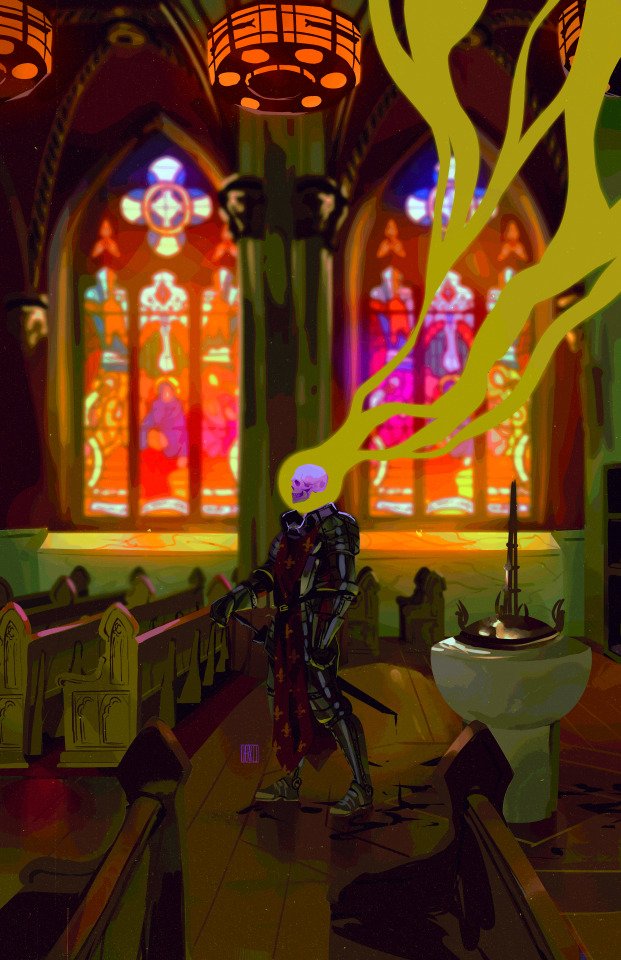
ye who know of death before life is done ⚜🩸
#my art#digital art#illustration#original art#artists on tumblr#art#medieval#knight art#digital painting#same church used as reference in 'white light'#revisited 5 years later
10K notes
·
View notes
Text
closest bruce comes to destroying the “brucie” persona is when he gets interviewed by a child and Cannot for the life of him Lie
#some 5 year old - brucie do you know why the sky is blue? bruce visibly shaking - do you know how light photons work ???#batfamily#batman#bruce wayne#batfam
19K notes
·
View notes
Text
being in love with a fictional character will make u produce art u didnt know u were capable of
~
[if ur part of the "fiction doesnt affect reality" crowd: please fuck off lol]
#me: oh teehee lets just do this for fun bc im bored and want to try smth i haven't done in a year#the art: hi im gonna turn out far above what u thought u had the skillset for#im convinced this is just beginners luck DBDJDKL or like...#one of those times where u just produce rly good art for a day or two and then it never happens again DBFHDKL#ur graced by the light of some creative spirit entity and then they fuck off into the void randomly and leave u with no abilities SBJDKDL#dandy.cmd
27K notes
·
View notes
Text
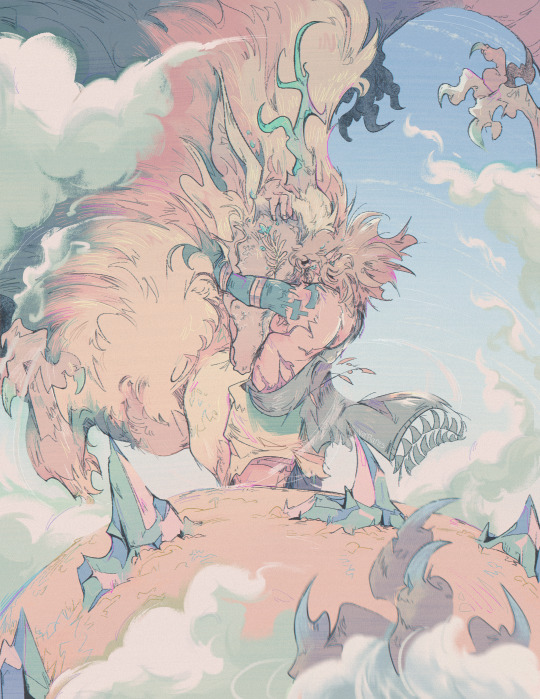
just how long is forever? // not long enough, with you
pssst. check this out on inprnt :]
#pssst also. you should click/zoom on this. for better quality and to see all my silly little details :] hooty hoo#this is my totkversary thing im just too impatient to wait till the 12th LOL. big shoutout to this game tht has ruined my life. and zelink.#zelink#light dragon#link#zelda#loz#totk#princess zelda#totk spoilers#link totk#zelda totk#tears of the kingdom#loz fanart#i had soooo much fun drawing this i really did. i think this is a good capstone piece for how much ive improved so far this year#i still have a long ways to go ofc but. i am pleased ^_^ nd i am glad i can use zink like experiments to do so hehe#anyway. YURI FOREVERRRRR BITCH#my art
17K notes
·
View notes
Text



concerning pastimes
#anyone wanna guess whats on the screen in the back#mostly playing around with perspectives and lighting here bc i need to draw more backgrounds but i also lost motivation halfway through#shadow#rouge#shadow the hedgehog#rouge the bat#team dark#sonic the hedgehog#sth#sonic#sonic fanart#sonic the hedgehog fanart#sth fanart#my art#shadow fanart#shadow the ultimate lifeform#fearless year of shadow#year of shadow#cryoshad
10K notes
·
View notes